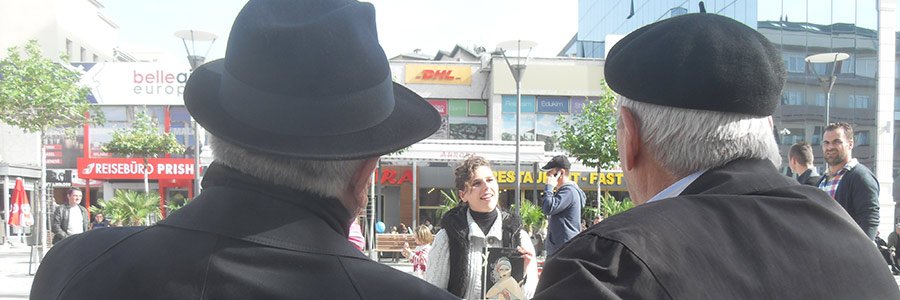The Chairs – An Intervention and Installation for Public Spaces

The Chairs is a community participation project that takes place in various locations simultaneously. It is a project that also operates through social media. It will one day become a film based installation project. It could quite possibly become one of the largest performance projects in the history of the world.
The Chairs is simple. It is about people – a lot of people – standing behind a chair, their chair, and telling the person who is sitting on this chair, a story.
The story they tell is about something that has happened to them whilst they have sat on this chair. Maybe they learnt something? Maybe they were given something? Maybe they sat down on it to deal with a moment when their life had changed? Maybe there is a meal that they remember whilst sitting on this chair; a meal with friends when a decision was made. Maybe their mother came to stay, their child had its first birthday, or they celebrated getting a new job. Maybe something truly terrible happened; maybe their heart was broken; maybe they suddenly realised that they had grown into the person they always wanted to become.
That’s it. Each story may be very short. They last as long as they last. But it is the fact that there are lots of chairs, lots of people, lots of stories, in one place that will give the piece its power. And the fact – and this is the key to the piece – that it is happening in (at least) two places at once; with the audience both hearing the story that is being told behind them and seeing a screen in which they can see people sat on rows of chairs and facing them, as the owners of those chairs stand behind them, also facing the screen, telling their story.
The Chairs takes place in a series of public spaces. It begins six months, one year, three years earlier. With arts organisations in a number of cities – at least ten, preferably fifty – promoting the project and encouraging participation.
People will be encouraged, assisted, provoked to bring their chairs – which must be portable – into the space on a certain day. The chairs will be arranged in rows. There will need to be at least one hundred chairs in each location in ten rows of ten. The owners of the chairs will stand behind them, passively. The audience will be invited, silently, to sit on a chair where they will hear the story attached to it.
And this space will be filmed and will be relayed live to one or more or all of the other cities or towns that are taking part in the project. And at each of the spaces there will be a large screen that will show one or more or all of the other cities or towns that are taking part. So if we get ten cities with one hundred chairs in each it may be possible to see one thousand chairs with one thousand people from all over the world standing behind them (and possibly one thousand people sitting on them).
If you are sitting on a chair the screen will be in front of you. You will see people from other cities sitting on chairs and facing you; just as those who tell the stories about these chairs from other cities will be facing you. Only the person who is telling you their story as you sit on their chair, will not be visible at this moment.
Each individual story will also be filmed separately by the contributing arts organisations creating a body of stories from which to create further work in the future.
The Chairs will bring people onto the streets in countries across the world. The Chairs will give people the chance to sit and listen to the stories of strangers. The Chairs will tell hundreds of small stories of life, love, birth and death. The Chairs will look and sound incredible.
